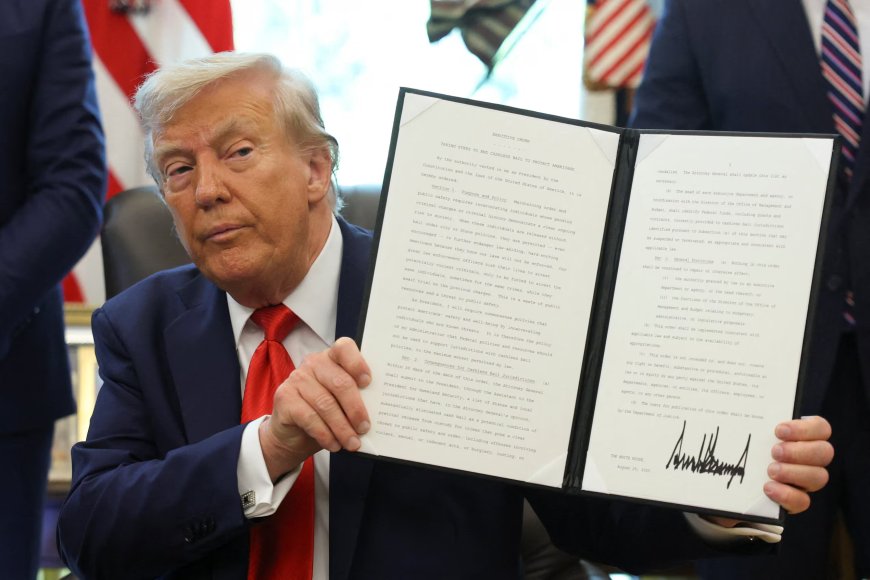Trump’s Law Enforcement Orders: Cashless Bail Ban and Flag Desecration Crackdown Spark Debate
President Donald Trump bans cashless bail and criminalizes flag desecration in new executive orders. Legal experts debate constitutional impacts.

President Donald Trump signed a sweeping set of executive orders this week aimed at reshaping law enforcement policy across the United States, with two provisions drawing particular attention: a ban on cashless bail programs and new federal penalties against flag desecration. The moves are being celebrated by Trump supporters as a strong reaffirmation of law and order, while critics warn of constitutional overreach and potential setbacks in criminal justice reform.
Cashless Bail Ban: Reversing Reform Momentum
The most controversial element of Trump’s new orders is the federal ban on cashless bail policies. These systems, widely adopted in states like New York, New Jersey, and California in recent years, were designed to reduce incarceration rates for non-violent offenders who could not afford bail. Instead of holding defendants simply because of financial hardship, judges relied on risk assessments and community supervision.
Trump’s order argues that such systems have led to “a revolving door of crime,” citing cases where defendants released under cashless bail allegedly reoffended within days. The order requires states to reinstate cash bail requirements in most felony and misdemeanor cases if they wish to continue receiving federal law enforcement funding.
According to the Bureau of Justice Statistics, nearly 450,000 people were held in local jails in 2022 because they could not post bail — a figure reform advocates had sought to lower. Critics argue that Trump’s ban could return the U.S. to an era of overcrowded jails disproportionately impacting low-income defendants.
Historical Precedents in Bail Reform
Cash bail has long been a contested element of American justice. In 1966, the Bail Reform Act under President Lyndon B. Johnson first pushed courts to release defendants without excessive bail. Two decades later, in 1984, Congress reversed course, giving judges broader discretion to detain individuals deemed dangerous.
Trump’s order fits within this cyclical history: a pendulum swing away from reform and toward public safety. Legal scholars point out that courts, including the U.S. Supreme Court, have consistently upheld bail discretion, though rarely at the federal mandate level. Some warn that Trump’s directive could face constitutional challenges, particularly under the Eighth Amendment’s prohibition on excessive bail.
Flag Desecration Penalties: A Symbolic Flashpoint
Alongside the bail order, Trump introduced new federal penalties against flag desecration, making it a crime punishable by fines up to $250,000 or two years in prison. While several states already criminalize the act, the Supreme Court’s landmark decision in Texas v. Johnson (1989) struck down similar laws, declaring flag burning a form of protected free speech.
Trump’s move is a direct challenge to that precedent. Supporters frame it as defending national pride, especially at a time when public displays of patriotism remain politically charged. Opponents, including First Amendment advocates, argue the executive order will not withstand judicial scrutiny. The National Constitution Center notes that repeated congressional attempts to pass a constitutional amendment against flag burning have failed for decades, underscoring the uphill battle Trump faces.
Legal Experts Weigh In
Constitutional law experts remain divided:
-
Supporters argue Trump is responding to a legitimate public safety crisis, restoring order and ensuring respect for national symbols.
-
Opponents see the orders as legally vulnerable and politically motivated, designed more to energize Trump’s base ahead of the 2026 midterms than to stand up in court.
Professor Michael Adler of Georgetown Law observed, “What we are seeing is a textbook example of executive overreach — testing the boundaries of constitutional protections under the guise of law enforcement.”
Political and Social Implications
The timing of the orders suggests a broader political calculation. With crime and national unity dominating Trump’s rallies, the executive actions serve as both policy and campaign platform. Analysts predict immediate lawsuits, particularly over the flag desecration provision, with federal courts likely to halt enforcement pending review.
Meanwhile, activists warn that the bail ban could overwhelm local jails, disproportionately harm minority communities, and roll back years of bipartisan progress in justice reform. On the other hand, polling shows strong public support for tougher bail policies, especially in suburban areas that will be crucial in the 2026 midterm elections.
Conclusion
President Trump’s latest executive orders mark a decisive turn in U.S. law enforcement policy, pitting law-and-order priorities against longstanding civil liberties. Whether these measures stand the test of courts or history remains to be seen, but one thing is clear: they have already reignited one of America’s oldest debates — how to balance freedom, justice, and national identity.











